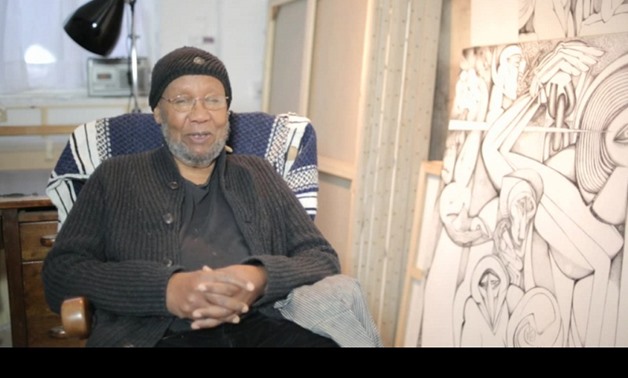
Screencap of Ibrahim El-Salahi, April 27, 2018 –Youtube/Tate.
CAIRO – 27 April 2018: An exhibition dedicated to the works of Sudanese artist Ibrahim El-Salahi is being held in Oxford from April 19 until September 2. This marks the first solo exhibition for Salahi's works in Oxford, the town he has lived in for 20 years.
Born in 1930 in Sudan, Salahi is one of the most influential Sudanese artists living today. A pioneer of African Modernism, Salahi is a leader of the Kharthoum School, which he co-founded in 1960. This included a group of Sudanese artists who blended art styles such as abstract modernist art with Islamic calligraphy and other traditional Sudanese motifs, giving birth to a new and distinct form of art tinged with an African sensibility like nothing else.
[Reborn Sounds of Childhood Dreams (1961-1965) by Ibrahim Salahi, June 25, 2014 - Flickr/Gautier Poupeau]
Yet beyond his art, Salahi is also notable for being a political prisoner. In 1975, he was arrested without charge in Sudan following his return from London, after he managed to achieve international attention. He was previously an undersecretary for Sudan’s minister of culture, but was stripped of his rank due to his politics. Despite this, prison did not stop Salahi from creating. Indeed, he wrote a book of Islamic calligraphy and illustrations titled "Prison Notebook" in 1976, which now resides at the Museum of Modern Art in New York City.
 [Reborn Sounds of Childhood Dreams (1961-1965) by Ibrahim Salahi, June 25, 2014 - Flickr/Gautier Poupeau]
[Reborn Sounds of Childhood Dreams (1961-1965) by Ibrahim Salahi, June 25, 2014 - Flickr/Gautier Poupeau]
"Ibrahim El-Salahi: A Sudanese Artist in Oxford" features never-before-seen drawings, alongside some of Salahi's most distinctive works and even his newest art, which he made on envelopes and letters while suffering from chronic pain. A unique element of the exhibition includes the contrast of Salahi's body of work to ancient examples of Sudanese art taken from the Ashmolean Museum's collection, such as pottery including animals that Salahi also uses in his art. This serves to showcase a theme of Salahi's work, in that "the past is linked to the present", according to the University of Oxford.

Comments
Leave a Comment